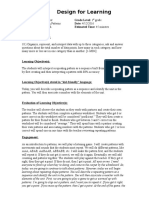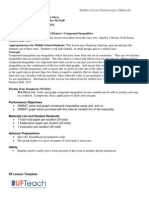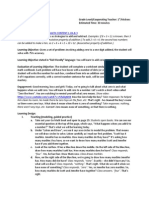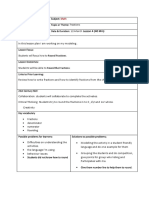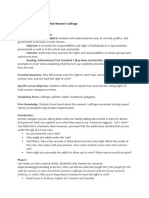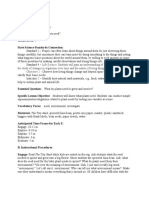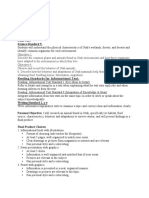Lesson Title: Sharing & Critiquing Peer Solution Strategies For Put Together With Total Grade: 1 State Standard Strand
Lesson Title: Sharing & Critiquing Peer Solution Strategies For Put Together With Total Grade: 1 State Standard Strand
Uploaded by
api-466313227Copyright:
Available Formats
Lesson Title: Sharing & Critiquing Peer Solution Strategies For Put Together With Total Grade: 1 State Standard Strand
Lesson Title: Sharing & Critiquing Peer Solution Strategies For Put Together With Total Grade: 1 State Standard Strand
Uploaded by
api-466313227Original Title
Copyright
Available Formats
Share this document
Did you find this document useful?
Is this content inappropriate?
Copyright:
Available Formats
Lesson Title: Sharing & Critiquing Peer Solution Strategies For Put Together With Total Grade: 1 State Standard Strand
Lesson Title: Sharing & Critiquing Peer Solution Strategies For Put Together With Total Grade: 1 State Standard Strand
Uploaded by
api-466313227Copyright:
Available Formats
Erin Koerselman
Observed Lesson Plan
Math Methods
Lesson Title: Sharing & Critiquing Peer Solution Strategies for Put Together with Total
Unknown Word Problems.
Grade: 1
State Standard Strand:
Operations and Algebraic Thinking (1.OA)
Standard 1.OA.6: Add and subtract within 20.
Core Objective:
Represent and solve problems involving addition and subtraction within 20 by critiquing peer
solution strategies.
Essential Question:
How does sharing and critiquing peer work help us understand solution strategies for put
together with total unknown word problems?
Specific Lesson Objective:
Students will be able to share and critique peer solution strategies for put together with total
unknown word problems.
Materials:
Application Packet (kids already have)
White Board
Smart Board
Power Point Slides
Problem Set (kids have their copies)
Marker
*This lesson is from Eureka.
Part 1: Application Problem (on rug, 10-15 minutes)
• Post and read the application problem: Nicholas bought 9 green apples and 7 red apples.
Sofia bout 10 red apples and 6 green apples. Sofia thinks she has more apples than
Nicholas. Is she right?
What is this problem about?
• apples, how many apples Nicholas has and how many apples Sofia has, determining if
Sofia is correct in her thinking that she has more
What are our quantities? Let’s box our quantities- we are not coloring them in, just putting a box
around the quantities.
• Students point out the quantities and box them.
Are any of these quantities the total?
• No, they are parts (addends).
Are we dealing with only one problem in this story?
• No, there are two problems. We have to find the total number of apples that Nicholas has
and the total number of apples that Sofia has.
• Read the story problem again and show that the addends 9 & 7 belong with Nicholas and
the addends 10 & 6 belong with Sofia.
• Tell students to choose a strategy they have learned to show their work on the left side of
their application page.
You will show your work for Nicholas and your work for Sofia.
• Then, tell them they will write number sentences to show how many apples Nicholas and
Sofia each have.
You will write two number sentences, one showing how many apples Nicholas has and one
showing how many apples Sofia has.
• Read the application problem 1-2 more times or as needed.
• Observe student strategies.
So, is Sofia right? Does she have more apples than Nicholas?
Does anyone think Sofia is right?
Who thinks Sofia is wrong? Why? Who agrees?
• On board, represent some student work that you observed and write the number
sentences.
• On back of application page, students write a sentence to answer the story problem.
If we’re not sure what to write, what can we do?
• Go back to the story problem.
Right! What sentence in the story problem helps us know what to write?
• “Is she right?”
• Have a few students share what they wrote.
• Write the true number sentence: 9+7=10+6.
Is 9+7 equal to or the same as 10+6? Is this a true number sentence?
• Quickly discuss and correct any misconceptions if necessary.
Transition to desks:
I want everyone to go quickly and quietly back to your desk, put away your application packet,
and leave your white board and accoutrements on your desk.
Part 2: Concept Development (30 minutes)
• Project and read: Louie made 7 puppets out of paper bags. Roberto made 6 puppets out of
socks. How many puppets did the boys make?
• Show paper bag puppet in case some don’t know what a puppet is.
• Repeat problem and pause to give them time to think.
Think-Pair-Share: Turn and talk to your elbow partner about how you would solve this problem.
• Roam room to listen to student strategies.
• Project the Student A sample.
How did Student A solve this problem? Explain to your partner what this student was thinking.
• Counted all the circles starting with 1, used counting on.
• Project the Student B sample.
How did Student B solve this problem? Can you explain his thinking? Turn and talk to your
partner.
• Drew shapes in 5-groups. When he made ten starting with 7, he drew a frame around it,
so you can see 10 and 3. His strategy was to make ten from 7 by breaking 6 into 3 and 3.
• Project the Student C sample.
How did Student C solve this problem? How is it similar and different from Student B’s work?
• She didn’t need to make a picture. She used the make ten strategy. But instead of making
ten with 7, she made ten with 6 and broke apart 7 into 4 and 3.
• Project the Student D sample.
How did Student D solve the problem?
• He drew a picture, but it’s a little hard to count because the shapes are not organized. He
probably had to count all of them, starting with 1. Or maybe he counted on from 7.
Do all these show ways to solve the problem? Which way seems like it’s a better shortcut? Turn
and talk to your partner.
• Roam room and listen.
• Display teacher work (purposely wrong).
Look, I found one more! Actually, I did this one. Pretend you are my teacher and take a look at
my work. What are your thoughts?
• Your picture is organized. I like the way you drew your circles in a 5-group. But you
didn’t solve it right. The picture doesn’t make sense.
What do you mean? Can you draw a picture that will help me see how I can make this better?
• Roam room.
How can you help me get the correct answer? What did I do wrong?
• You need to make ten by taking apart 3 from 6. You just added 10 and 6 here, not 10 and
3.
Good work! And thank you for pointing out what you liked about my work. Do you think it’s
important we point out what we like about each other’s work?
Let’s try another problem.
• Project and read aloud: Louie glued on 5 pieces of brown yarn for his puppet’s hair. He
then glued on 8 pieces of red yarn for more hair. (Explain that yarn is like string but
softer and comes in colors.) How many pieces of yarn did Louie use?
Solve this problem by showing your work clearly on your personal white board.
• Tell students they will swap personal white boards with their partners and discuss the
following:
§ Study what strategy your partner used.
§ Did you get the same answer?
§ Take turns to explain your partner’s strategy.
§ Are your strategies similar? How? Are they different? How?
§ What did your partner do well?
§ Which strategy is more efficient?
• Let students know to be prepared to share how their partner solved the problem.
• Roam room and listen to students. Ask about findings.
• Ask a couple students to share how their partner solved the problem.
• If time allows, repeat partner work with 9+7, 8+6, and 7+7.
Transition:
• Have students clean off their personal white boards and put away their boards and
accoutrements. Have students take out their problem set packet and a pencil.
Part 3: Problem Set (7-10 minutes)
• Have students write their name on their problem set. Everyone point to the top of the
page where it says “name” and write your name.
• Read problem 1 and do a and c with the class.
• Read problem 2 and explain they will need to correct c from problem 1 in this space.
• Read direction for 3 and 4. If time, have them do number 3.
• If time, have students work on the remaining problem set.
• Remind students they will finish the problem set when they return from recess.
• Have students line up for recess.
Assessment:
Formal: Students will correct and turn in problem sets the next day.
Informal: While roaming the room during partner-shares, I will assess student
understanding and use questioning to help direct them toward sharing and critiquing each other’s
work.
Adaptations: While going through the problem set, square the quantities in each problem. While
kids work on problem set, conference with kids who need extra support.
You might also like
- Singapore MathDocument116 pagesSingapore Mathkarlamae65792% (25)
- Classroom of The Elite 2nd Year Vol. 2Document354 pagesClassroom of The Elite 2nd Year Vol. 2Masud Ahmed100% (10)
- Siop Lesson PlanDocument4 pagesSiop Lesson Planapi-273729585100% (1)
- Word Problem LessonDocument7 pagesWord Problem Lessonapi-301858309No ratings yet
- Lesson Plan 1 - Josie JaggersDocument10 pagesLesson Plan 1 - Josie Jaggersapi-487435379No ratings yet
- Unit Lesson PlansDocument22 pagesUnit Lesson Plansapi-594689407No ratings yet
- Math Lesson Plan 3Document3 pagesMath Lesson Plan 3api-273812022No ratings yet
- Multiplying Fractions - Avondale - 4Document6 pagesMultiplying Fractions - Avondale - 4api-302151781100% (1)
- Dakota State University College of Education Lesson Plan FormatDocument3 pagesDakota State University College of Education Lesson Plan Formatapi-277395000No ratings yet
- Unit - 5 Multiplication LessonsDocument21 pagesUnit - 5 Multiplication Lessonsapi-690898964No ratings yet
- Multiplying Dividing Mixed NumbersDocument2 pagesMultiplying Dividing Mixed Numbersapi-240687848No ratings yet
- Modeling: Having KittensDocument22 pagesModeling: Having KittenscrazymrstNo ratings yet
- Lesson Plan #1Document5 pagesLesson Plan #1Savannah WilcoxsonNo ratings yet
- Part B Lesson Plans For Learning SegmentDocument12 pagesPart B Lesson Plans For Learning Segmentapi-205136734No ratings yet
- Pattern Lesson PlanDocument6 pagesPattern Lesson Planapi-302405971100% (1)
- Math Trailblazers Unit 6 Grade 3Document43 pagesMath Trailblazers Unit 6 Grade 3api-566036687No ratings yet
- Model Drawing Animations Grade 1Document27 pagesModel Drawing Animations Grade 1ektadograNo ratings yet
- Unit Lessons 2Document21 pagesUnit Lessons 2api-655344816No ratings yet
- Math LessonsDocument6 pagesMath Lessonsapi-340523458No ratings yet
- Third Observation Lesson - MathDocument4 pagesThird Observation Lesson - Mathapi-356771318No ratings yet
- Indiana Wesleyan University Elementary Education Math Lesson Plan CAEP 2018 K-6 Elementary Teacher Preparation StandardsDocument8 pagesIndiana Wesleyan University Elementary Education Math Lesson Plan CAEP 2018 K-6 Elementary Teacher Preparation Standardsapi-386069090No ratings yet
- Direct Social Studies LessonDocument3 pagesDirect Social Studies Lessonapi-284220275No ratings yet
- TPT Lesson PlanDocument2 pagesTPT Lesson Planapi-706945539No ratings yet
- Lesson PlansDocument18 pagesLesson Plansapi-301495220No ratings yet
- 1st and 2nd Grade ObservationsDocument37 pages1st and 2nd Grade ObservationsMarino AcuñaNo ratings yet
- Word Problems With 3 Addends RationaleDocument7 pagesWord Problems With 3 Addends Rationaleapi-272902100No ratings yet
- Elizabeth Haro Observation 2Document2 pagesElizabeth Haro Observation 2api-673724927No ratings yet
- Mcneill lp1 Mmms f12 FinalDocument9 pagesMcneill lp1 Mmms f12 Finalapi-217042382No ratings yet
- Observed Lesson 1 - Adding ZeroDocument7 pagesObserved Lesson 1 - Adding Zeroapi-241572695No ratings yet
- February 28, 2023 - PPT in Math 2 - q3 - Day 2 - Week 4Document48 pagesFebruary 28, 2023 - PPT in Math 2 - q3 - Day 2 - Week 4Siennadonna GerminoNo ratings yet
- Math Curse LessonDocument8 pagesMath Curse Lessonapi-252494734No ratings yet
- Math LessonDocument7 pagesMath Lessonapi-380761542No ratings yet
- Guy Willey EdTPA Lesson OneDocument4 pagesGuy Willey EdTPA Lesson Onelauraemily1No ratings yet
- Teaching Standard 1Document5 pagesTeaching Standard 1Melissa AdamsNo ratings yet
- Lesson 3 Week 11Document4 pagesLesson 3 Week 11api-208843281No ratings yet
- Addition Reinforcing The Doubles StrategyDocument7 pagesAddition Reinforcing The Doubles Strategyapi-382824641No ratings yet
- Lesson Plan-2Document5 pagesLesson Plan-2api-464424894No ratings yet
- Usr Local SRC Education - Com Files Static Lesson-Plans Problem-Solving-Steps Problem-Solving-StepsDocument2 pagesUsr Local SRC Education - Com Files Static Lesson-Plans Problem-Solving-Steps Problem-Solving-Stepsregine.grefilNo ratings yet
- Formal Lesson Plan Math Lesson 25Document4 pagesFormal Lesson Plan Math Lesson 25api-303421137100% (1)
- Lesson Plan 11 7math Katelyn SheridanDocument5 pagesLesson Plan 11 7math Katelyn Sheridanapi-253725168No ratings yet
- Mip 4 6b Solv Cont ProbDocument5 pagesMip 4 6b Solv Cont ProbJesson AlbaranNo ratings yet
- Week 1 (Wednesday, February 8)Document9 pagesWeek 1 (Wednesday, February 8)api-354418173No ratings yet
- Toddkassandra 001digitalproductDocument7 pagesToddkassandra 001digitalproductapi-338759771No ratings yet
- Unit 11, Lesson 1 - Multiplying Fractions and Whole Numbers March 20, 2012Document2 pagesUnit 11, Lesson 1 - Multiplying Fractions and Whole Numbers March 20, 2012carolynhart_415No ratings yet
- Lesson Plan 4Document6 pagesLesson Plan 4Anonymous X7u8sMNo ratings yet
- Asw Project Laura Welker EDEL 311 University of Nevada Las Vegas College of EducationDocument23 pagesAsw Project Laura Welker EDEL 311 University of Nevada Las Vegas College of Educationapi-433437108No ratings yet
- Math Lesson 1Document3 pagesMath Lesson 1api-316589964No ratings yet
- Halle's Math Lesson PlanDocument9 pagesHalle's Math Lesson Planhnc27760No ratings yet
- Lesson Plan Lesson Standards / Essential QuestionsDocument4 pagesLesson Plan Lesson Standards / Essential Questionsapi-316638147No ratings yet
- Math Lesson Plan and PresentationDocument11 pagesMath Lesson Plan and Presentationapi-514564329No ratings yet
- 10 As A FactorDocument3 pages10 As A Factorapi-549715115No ratings yet
- Tree DiagramDocument21 pagesTree DiagramriefardNo ratings yet
- Edtpa Lesson Plan Template : Activity Description of Activities and Setting TimeDocument3 pagesEdtpa Lesson Plan Template : Activity Description of Activities and Setting Timeapi-298532630No ratings yet
- Simmons Small Group Lesson PlanDocument6 pagesSimmons Small Group Lesson Planapi-350178228No ratings yet
- Lesson Plan On Multiplying FractionsDocument6 pagesLesson Plan On Multiplying Fractionsapi-282209377No ratings yet
- Lesson PlansDocument22 pagesLesson Plansapi-301030635No ratings yet
- Adding and Subtracting Whole NumbersDocument7 pagesAdding and Subtracting Whole Numbersapi-234983083100% (1)
- Lesson Plan 4Document3 pagesLesson Plan 4FatimaNo ratings yet
- Erin Koerselman: EducationDocument1 pageErin Koerselman: Educationapi-466313227No ratings yet
- Grade 6 HaikusDocument7 pagesGrade 6 Haikusapi-466313227No ratings yet
- Grade 4 Womens Suffrage SsDocument2 pagesGrade 4 Womens Suffrage Ssapi-466313227No ratings yet
- Grade 3 Ela ArtsDocument4 pagesGrade 3 Ela Artsapi-466313227No ratings yet
- Grade 1 Science PlantsDocument4 pagesGrade 1 Science Plantsapi-466313227No ratings yet
- Grade 4 Science Animal ProjectDocument5 pagesGrade 4 Science Animal Projectapi-466313227No ratings yet
- Grade 6 Literacy Tone MoodDocument8 pagesGrade 6 Literacy Tone Moodapi-466313227No ratings yet
- Grade 6 EpitaphsDocument4 pagesGrade 6 Epitaphsapi-466313227No ratings yet
- 4th Grade Math 4Document2 pages4th Grade Math 4api-466313227No ratings yet
- 4th Sensory Detail Lesson PlanDocument2 pages4th Sensory Detail Lesson Planapi-466313227No ratings yet
- Ss Ancient EgyptDocument9 pagesSs Ancient Egyptapi-466313227No ratings yet
- Standard 8 Reflection Continuous Growth Artifact 1Document1 pageStandard 8 Reflection Continuous Growth Artifact 1api-466313227No ratings yet
- Standard 8 Reflection Continuous Growth Artifact 1Document11 pagesStandard 8 Reflection Continuous Growth Artifact 1api-466313227No ratings yet
- Standard 10 Professional Ethical Behavior Artifact 2Document2 pagesStandard 10 Professional Ethical Behavior Artifact 2api-466313227No ratings yet
- Final Term Assessment FALL 2020: Student's Name Noor Nabi Shaikh Registration Number 1711125Document8 pagesFinal Term Assessment FALL 2020: Student's Name Noor Nabi Shaikh Registration Number 1711125Noor Nabi ShaikhNo ratings yet
- T Claassens Science Fair Presentation-Landscape 2 2Document12 pagesT Claassens Science Fair Presentation-Landscape 2 2api-527913909No ratings yet
- Patravali Part 3 Harsh-Converted (14882)Document213 pagesPatravali Part 3 Harsh-Converted (14882)saumyaNo ratings yet
- Exercise02a Kinematic OnlyDocument2 pagesExercise02a Kinematic Only22000496No ratings yet
- MEE 505 - FORTRAN - Lesson-01ADocument16 pagesMEE 505 - FORTRAN - Lesson-01AOlamide PaulNo ratings yet
- Cbse Class 9 Computer Science Sample Paper Sa1 2014 Paper 3Document23 pagesCbse Class 9 Computer Science Sample Paper Sa1 2014 Paper 3Rekha Pinto0% (1)
- Button Button (#1)Document4 pagesButton Button (#1)jaelajeanine326No ratings yet
- Anna Karenina Leon TolstoiDocument30 pagesAnna Karenina Leon TolstoiAlexaNo ratings yet
- Name: Mayell Andres Suarez Caballero Date: June 20 Minimalist: A Documentary About Important ThingsDocument2 pagesName: Mayell Andres Suarez Caballero Date: June 20 Minimalist: A Documentary About Important ThingsAndres Suarez CaballeroNo ratings yet
- Module 1 (Social Innovation)Document7 pagesModule 1 (Social Innovation)Marinette Medrano50% (2)
- Be 1 Sem Basic of Civil Engineering 3285 Summer 2019Document1 pageBe 1 Sem Basic of Civil Engineering 3285 Summer 2019Devashish SahasrabudheNo ratings yet
- 13 - Kunz - LADLE REFRACTORIES FOR CLEAN PDFDocument12 pages13 - Kunz - LADLE REFRACTORIES FOR CLEAN PDFemregnesNo ratings yet
- Han Et Al 2022Document29 pagesHan Et Al 2022sabahrasheed1No ratings yet
- Book Reviews: The Engineering Handbook, Edited by Richard C. DorfDocument3 pagesBook Reviews: The Engineering Handbook, Edited by Richard C. DorfZasbir Rahman ZayanNo ratings yet
- Result Summary: Combined Foundation Design (Aci 318-11)Document32 pagesResult Summary: Combined Foundation Design (Aci 318-11)Napoleon CarinoNo ratings yet
- Marketing Management 2021 1st Sem - Midterm LessonsDocument33 pagesMarketing Management 2021 1st Sem - Midterm LessonsRuss GomezNo ratings yet
- TOS TLE Food Processing SEcond QuarterDocument1 pageTOS TLE Food Processing SEcond QuarterMaxivel DomosmogNo ratings yet
- HBO Module 5 - CommunicationDocument50 pagesHBO Module 5 - CommunicationLorraine Dela CruzNo ratings yet
- Summary of Some Useful Equations: HYPERS301.x Hypersonics From Shock Waves To ScramjetsDocument28 pagesSummary of Some Useful Equations: HYPERS301.x Hypersonics From Shock Waves To ScramjetsShivam AgarwalNo ratings yet
- ESG: Research Progress and Future Prospects: SustainabilityDocument28 pagesESG: Research Progress and Future Prospects: SustainabilityWan Nordin Wan HussinNo ratings yet
- QCBioW21 - IPfM2022F - Workbook - NoviceVersion - Ipynb - ColaboratoryDocument59 pagesQCBioW21 - IPfM2022F - Workbook - NoviceVersion - Ipynb - ColaboratoryTAUHID ALAMNo ratings yet
- Wonders Home School Grade 4Document347 pagesWonders Home School Grade 4Alejandro Albaladejo PintadoNo ratings yet
- Go, Charles Warren M. (Problem Set 4)Document19 pagesGo, Charles Warren M. (Problem Set 4)Charles Warren GoNo ratings yet
- Embionada, Larz Omeir - MODULE 5Document4 pagesEmbionada, Larz Omeir - MODULE 5Embionada, Larz OmeirNo ratings yet
- SoundDocument8 pagesSoundHagen SeahNo ratings yet
- M. B. A S - H S (M) Pampano St. Kaunlaran Village, Caloocan City Telefax No. 288-5093Document2 pagesM. B. A S - H S (M) Pampano St. Kaunlaran Village, Caloocan City Telefax No. 288-5093Joselyn EntienzaNo ratings yet
- RBI Lesson Plan Demo editED NEW For Science 8Document7 pagesRBI Lesson Plan Demo editED NEW For Science 8Chrisel Luat LopezNo ratings yet
- Sustainable Supply Chain Management at MahindraDocument3 pagesSustainable Supply Chain Management at MahindraShivam ChandraNo ratings yet
- 2-5-3 English L - LDocument19 pages2-5-3 English L - LAyush RajNo ratings yet














